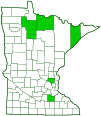Golden Coral Fungus
(Ramaria aurea)
Conservation • Description • Habitat • Ecology • Distribution • Taxonomy
Conservation Status |
|
|||||||
| IUCN Red List | not listed |
|||||||
| NatureServe | NNR - Unranked |
|||||||
| Minnesota | not listed |
|||||||
Description |
||
Golden Coral Fungus is a medium-sized, coral-like fungus. It is common in Europe and eastern North America. In the United States it occurs from Maine to Minnesota, south to Alabama, and in California, Washington, and Utah. It obtains its nutrients from decaying wood (saprobic). It is found in deciduous and mixed forests, alone or in groups, on the ground under hardwoods. The fruiting body is 2¾″ to 6″ (7 to 15 cm) tall, 4″ to 6″ (10 to 15 cm) wide, and profusely branched above short, thick stalk. The stalks are sometimes fused into a thick, fleshy base. The branches are coral-like, smooth, and mostly erect. They are never ribbon-like. When young they are golden yellow or whitish with bright yellow tips. As they age they fade to dull brown. Spores are produced by cells (basidia) lining the outer surface of the upright branches. The flesh is fibrous and brittle, never gelatinous. It does not change color when bruised or cut. Eating is not recommended due possible confusion with several species that can cause nausea, vomiting, and diarrhea. The spore print is orangish-yellow. |
||
Similar Species |
||
Habitat and Hosts |
||
Deciduous and mixed woodlands. Hardwoods. |
||
Ecology |
||
Season |
||
Summer and fall |
||
Distribution |
||||
|
Sources |
|||
| 2/2/2023 | ||||
Occurrence |
||||
|
||||
Taxonomy |
|||
| Kingdom | Fungi (Fungi) | ||
| Subkingdom | Dikarya | ||
| Phylum | Basidiomycota (Basidiomycete Fungi) | ||
| Subphylum | Agaricomycotina (Higher Basidiomycetes) | ||
| Class | Agaricomycetes (Mushrooms, Bracket Fungi, Puffballs, and Allies) | ||
| Subclass | Phallomycetidae | ||
| Order | Gomphales | ||
| Family | Gomphaceae | ||
| Genus | Ramaria (coral fungi) | ||
Synonyms |
|||
Clavaria aurea Ramaria flavobrunnescens |
|||
Common Names |
|||
| Golden Coral Fungus | |||
Glossary
Saprobic
A term often used for saprotrophic fungi. Referring to fungi that obtain their nutrients from decayed organic matter.
Visitor Photos |
|||||
Share your photo of this fungus. |
|||||
| This button not working for you? Simply email us at info@MinnesotaSeasons.com. Attach one or more photos and, if you like, a caption. |
|||||
|
|||||
MinnesotaSeasons.com Photos |
|||||
|
|||||

Visitor Videos |
|||
Share your video of this mammal. |
|||
| This button not working for you? Simply email us at info@MinnesotaSeasons.com. Attach a video, a YouTube link, or a cloud storage link. |
|||
Other Videos |
|||

Visitor Sightings |
|||||
Report a sighting of this fungus. |
|||||
| This button not working for you? Simply email us at info@MinnesotaSeasons.com. Be sure to include a location. |
|||||
|
|||||
MinnesotaSeasons.com Sightings |
|||||
|
|||||

Created: 10/4/2019
Last Updated:


